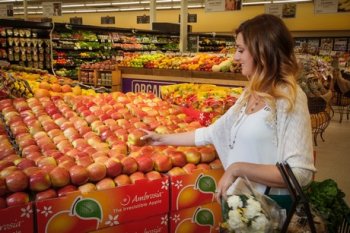
The result has been slower sales on many traditional varieties as supermarkets look to fill shelves with high demand new crop apples like Honeycrisp and Ambrosia.
Washington State apple shipments through 2 November are 19.3% below the same period in 2014, but nearly 9% higher than two years ago. Early season predictions of smaller-sized fruit and supply reductions, particularly in Gala, Red Delicious and Golden Delicious are proving to be accurate.
At the supermarket level, Nielsen data reveals that retail pricing shifted up during the first few weeks of the new season while sales dollars and volume declined. The data shows that for the first four weeks of the apple season through 26 September 2015, total US apple sales declined by 2.6% while volume dropped by 3.9%. Average retail pricing for the total US moved up 1.4% to $1.54 per pound.
Apple category growth continues to be propelled by the newer managed varieties and brands. The overall decline in apple category performance was offset by double-digit sales increases among many emerging varieties. Honeycrisp, Pink Lady, Ambrosia Sweetango and KIKU brand apples all posted strong sales increases over last year for the four-week September startup period.
Some traditional popular apples showed significant sales declines. Gala (-8.0%), Red Delicious (-16.9%), Golden Delicious (-12.1%) and McIntosh (-9.9) all lost sales dollars in September compared to the same period last year.
“The Nielsen data continues to show that consumer purchase priorities are shifting in the apple category,” said Steve Lutz, Vice President of Marketing for CMI. “Consumers are changing which apples they buy and demonstrating they will pay a premium for the products they really like.”
Don Patella, Regional Marketing Director for CMI, noted Nielsen data showing that McIntosh sales dropped by nearly 10% year over year despite having one of the lower retail price points in the category. Conversely, Ambrosia had the largest sales increase in the category while selling at roughly $2.40 per pound, one of the higher retail prices of any apple in the month of September. “Of the apples that sold over $2.00 per pound, 14 out of 15 had increased dollars for the period. Of the apples that sold at $1.50 per pound or lower, only four had increased sales.”
“It is evident that discount pricing alone will not build a healthy category in the coming year,” Patella said. “The real opportunity this year is making sure stores have the right products and position on the shelf. More importantly, stores need to review shelf allocation to make sure they have the right amount of space dedicated to these hot emerging varieties.”
Source: Columbia Marketing International



 Classifieds
Classifieds

